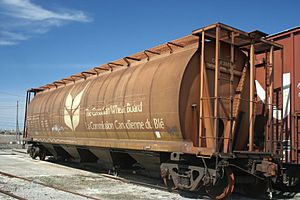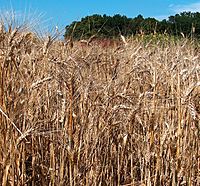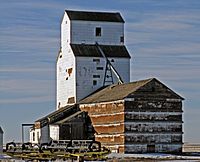Canadian Wheat Board facts for kids
| Commission canadienne du blé | |
 Canadian Wheat Board Building (on right) |
|
| Agency overview | |
|---|---|
| Formed | 1935 |
| Dissolved | 2015 |
| Type | Marketing board |
| Jurisdiction | Government of Canada |
| Headquarters | Winnipeg, Manitoba |
| Parent agency | (Formerly) Agriculture and Agri-Food Canada |
| Key document |
|
The Canadian Wheat Board (French: Commission canadienne du blé) was a special organization in Western Canada. It helped farmers sell their wheat and barley. The Canadian government created it in 1935.
The CWB was the only buyer of wheat and barley from farmers in Alberta, Saskatchewan, Manitoba, and parts of British Columbia. Farmers in these areas had to sell their grain through the CWB. This system was called the "Single Desk." The CWB acted for farmers, giving them all the profits from sales.
In 2012, the CWB's "Single Desk" power ended. This happened because of a new law called the Marketing Freedom for Grain Farmers Act. The CWB then changed its name to simply CWB. It continued to operate as a grain company. Later, in 2015, a large part of CWB was bought by other companies. It then became part of G3 Canada Limited.
In 2011–2012, the CWB had one of its best sales years. It sold $7.2 billion worth of grain to over 70 countries. About $4.9 billion of that money went back to farmers.
Contents
- History of the Canadian Wheat Board
- Early Grain Boards
- Farmers Try Cooperatives (1920–1935)
- The CWB Returns and Grows (1935–2000)
- CWB and Genetically Modified Wheat (2004)
- How the CWB Worked for Farmers
- Grain Quality System
- Changes to the CWB (2006–2012)
- Farmers, Railways, and the CWB
- CWB and Selling Grain
- Arguments Against the CWB's "Single Desk"
- Arguments For the CWB's "Single Desk"
- International Complaints
- Western Canada's Feelings
- Calls to End the CWB
- CWB Sold to Other Companies (2012-2015)
History of the Canadian Wheat Board
Early Grain Boards
In the early 1900s, big companies controlled how grain was bought and moved in Western Canada. Farmers felt these companies had too much power. They liked how the government managed grain sales during World War I.
During the war, the government created special boards to control the grain trade. By 1917, the Board of Grain Supervisors had full control over wheat. They set fair prices across the country. Farmers wanted this system to continue after the war. They worried prices would drop.
So, the Canadian Wheat Board was created for the 1919 crop. Farmers got a guaranteed price right away. They also received more money later once all the grain was sold. This system was very popular. When the Board closed in 1920, many farmers were upset. Grain prices then dropped a lot, which made farmers even more suspicious of private trading.
Farmers Try Cooperatives (1920–1935)
After the first board closed, farmers tried to work together. They formed their own cooperative companies, called wheat pools. These pools bought Canadian wheat and sold it overseas. The Alberta, Saskatchewan, and Manitoba Wheat Pools became very big.
However, these pools ran into trouble when prices fell sharply in 1929. Many went bankrupt. Farmers still didn't want private traders to take over. So, they decided a government marketing board was the best idea.
The CWB Returns and Grows (1935–2000)
The Canadian Wheat Board was brought back in 1935. Its goal was to control grain prices and help farmers during the Great Depression. During World War II, the CWB's powers grew. It was given control over more crops like oats, barley, and corn. Selling grain to the CWB became mandatory for Western Canadian farmers in 1943. This was to help the war effort.
In 1965, the CWB became a permanent organization. Before that, its existence had to be renewed by Parliament. Later, the CWB's control over feed grains (grain used for animal food) was removed. Only wheat and barley for human food remained under its control.
CWB and Genetically Modified Wheat (2004)
The Canadian Wheat Board played a big role in stopping genetically modified (GM) wheat from Monsanto in 2004. The CWB found that many countries did not want GM wheat. They worried that if Canada approved GM wheat, other countries might stop buying all Canadian wheat. The CWB also found that many farmers did not want GM wheat. The CWB shared these findings with the government.
How the CWB Worked for Farmers
Farmers delivered their wheat and barley to grain elevators. The CWB then sold this grain to buyers around the world. Farmers received an initial payment when they delivered their grain. This was a part of the expected price. After the crop year ended, farmers received more payments. In the end, they received all the money from their grain sales, minus the CWB's operating costs. The government guaranteed the initial payments. This meant farmers always got paid, even if prices dropped unexpectedly.
Before 2011, the CWB was managed by a board of 15 directors. Ten of these directors were chosen by farmers. Four were appointed by the government. The president was also appointed by the government. After a new law in 2011, the elected board was replaced. Only four directors and the president were appointed by the government.
Until 2011, most farmers had to sell their wheat and barley through the CWB. If they didn't, they could face fines. Farmers in Eastern Canada and most of British Columbia could sell their grain freely. The new law in 2011 changed the CWB. It allowed farmers to choose if they wanted to sell their grain through the CWB or on their own.
Grain Quality System
Canada had a strict system for grading grain quality. This system was managed by the Canadian Grain Commission and enforced by the CWB. This helped Canada get better prices for its high-quality grain. Without the CWB, some believed farmers might lose these benefits.
Changes to the CWB (2006–2012)
Starting in 2006, the government began to make changes to the CWB. They wanted to end its "Single Desk" power. This led to many discussions and disagreements.
- In 2006, farmer elections for the CWB board showed strong support for keeping the "Single Desk."
- In December 2006, the government fired the CWB president, who supported the "Single Desk."
- In 2007, a vote showed that 62% of barley farmers wanted to end the CWB's control over barley.
- In 2008, a court ruled that the government could not break up the CWB without a new law.
- In December 2011, a new law called the Marketing Freedom for Grain Farmers Act was passed. This law ended the CWB's "Single Desk" power.
- On August 1, 2012, the "Single Desk" system officially ended.
Farmers, Railways, and the CWB
Some farmers believed the CWB helped them deal with powerful railway companies. They felt that without the CWB, farmers would be at the mercy of the railways. Before it was sold, the CWB owned many railway cars.
After the CWB's role changed, farmers sometimes struggled to get enough rail cars. This was especially true when grain had to compete with oil for space on trains. Even when railways were fined for not moving enough grain, the fines were often not big enough to make a difference to the large railway companies.
CWB and Selling Grain
The CWB helped farmers get the best prices for their grain. It did this by using a "tendering process." This meant that grain companies had to compete to offer the best prices to the CWB. Because the CWB sold grain for many farmers, it had more power to negotiate. This helped farmers get better deals than if they tried to sell their grain individually.
The CWB's job was to:
- Pay farmers a base price for their grain.
- Find markets around the world.
- Negotiate the best prices.
- Deliver the grain.
- Give farmers advance payments and final payments.
If grain prices went up, farmers got more money. If prices went down, the government helped cover losses. Farmers only paid for the costs of marketing and delivery.
Arguments Against the CWB's "Single Desk"
Some people believed farmers should be free to sell their grain however they wanted. They thought farmers could get better prices on their own. For many Western Canadian farmers, ending the "Single Desk" was about personal freedom.
The CWB's control over wheat and barley led some farmers to grow more canola and pulse crops. These crops had no price controls. With the "Single Desk" gone, farmers could choose crops based on what the global market wanted.
Some opponents suggested a "dual market" system. In this system, farmers could choose to sell through the CWB or on their own. However, supporters of the CWB said this would still end the "Single Desk" and its benefits.
Some also argued that the CWB increased the value of farmland. They believed that ending the "Single Desk" would lower land values. This could make it harder for retiring farmers to sell their land. But it could also make land cheaper for new farmers.
Arguments For the CWB's "Single Desk"
In a 2011 vote, 62% of wheat farmers wanted to keep the CWB's "Single Desk" power. Supporters believed that the CWB's combined selling power helped farmers get better prices. They argued that individual farmers would struggle to get good deals from large international companies.
Opponents disagreed, saying there was no clear proof that farmers got better returns. Farmers could already sell other crops like canola on their own. This showed that it was possible to succeed without the CWB's oversight.
Supporters of the CWB believed it gave individual farmers more power in the global market. They thought it helped farmers get higher prices, especially for Durum wheat. They feared that without the CWB, farmers would be in a difficult position, similar to the early 1900s. They worried farmers would have to compete against each other, leaving them at the mercy of big companies and railways.
International Complaints
Even though the CWB changed to fit international trade rules, American grain producers often complained about it. The World Trade Organization (WTO) ruled in 2003 that the CWB was a farmer marketing group, not a government subsidy. This decision was later changed. Canadian farmers received very little government support compared to farmers in the United States and Europe. The complaints about the CWB were a major issue between Canada and the United States.
Western Canada's Feelings
The fact that the CWB mainly dealt with crops from Western Canada caused some feelings of unfairness. Farmers in Eastern Canada and most of British Columbia were not forced to sell their grain through the CWB. This difference contributed to feelings of Western alienation in some parts of Canada.
Calls to End the CWB
Many groups wanted to end the CWB. They used the internet to share their ideas and gain support. In 2008, farmers voted in favor of keeping the CWB. However, new international trade talks suggested the CWB might lose its "Single Desk" power within five years if a new agreement was signed.
CWB Sold to Other Companies (2012-2015)
The government wanted to end the CWB's "Single Desk" power. After winning a majority of seats in the 2011 election, the government announced it would pass a law to do this. The CWB held votes among farmers, and most wanted to keep the "Single Desk." Despite these votes, the government removed the "Single Desk" on August 1, 2012. The government said the farmer votes were flawed.
The new law also set a plan for the CWB to become a private company by 2017. In April 2015, it was announced that a majority of the CWB would be bought by a group of companies from other countries. This group included companies from Bunge Limited and Saudi Arabia. The remaining part of the CWB would be owned by farmers.
A group of Canadian farmers tried to buy the CWB to keep it Canadian-owned. However, their offer was not accepted. On June 12, 2015, the government released new laws to handle the tax changes for farmers and the trust that would hold the farmers' share of the CWB.




